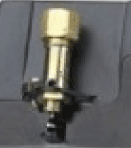Almost every air compressor has one, if it fails it causes problems, so what is a compressor unloader valve?
When an electric-motor driven air compressor tank gets full of air, the pressure switch reacts to this by shutting off the power to the compressor motor. The motor stops, and since the compressor pump is attached to the motor shaft, the compressor pump stops too.
This type of pump is reciprocating, meaning that the piston, or the pistons, cycle up and down or back and forth, and in so doing alternately pull air in or drive that air down into the tank, depending on where the piston is in the cycle.
This means that whenever the compressor pump stops, there will be some air trapped in the cylinder over the piston. Might be just a little, might be a lot, but some air will be there, and that air will add load to the motor when the motor tries to start and move the piston.

So much additional load could be added to the compressor motor that the motor cannot start against the load, and you may get a humming compressor motor or your motor could overheat and shut off on thermal overload. For sure, your compressor won’t be pumping air if the compressor motor cannot start.
That air that is trapped over the piston, or pistons, must go!
What is a compressor unloader valve, then?
It is a device, on of which is shown above, that opens when the compressor pressure switch trips to OFF, and lets any air that is trapped over the piston to vent so that when the air compressor motor tries to start, there is no load over the piston preventing this from happening.
Types of compressor unloader valves
Depending on the make and size of compressor, the unloader valve may take many forms.
The unloader valve that is shown in the image above is typically found on the side of a compressor pressure switch, and is operated by a toggle lever coming out of the side of the pressure switch.
Other compressor pressure switches have integral unloader valves. You can spot those by looking under the pressure switch and seeing if there is an air line plumbed into the bottom of the pressure switch, coming to it from the tank check valve.
Quite small air compressors have unloaders too. These typically are a small hole piercing a fitting or the line from the pump to the tank. A little air bleeds from the hole all the time the compressor is running, and for a few seconds after the compressor stops, effectively venting air from over the small piston. A compressor with this type of unloader typically has a pressure switch that is inserted into the tank under the compressor cover, and that style of switch has no place to connect an unloader valve.
Gasoline or diesel driven compressor unloader valves
Air compressors that are powered by a gasoline, diesel or even propane motor have unloader valves as well.
On these types of air compressors the unloader valve is also now known as a throttle valve. When the compressor tank pressure reaches the point where the electrically powered compressor would have the motor power cut off by the pressure switch, what happens on the fuel driven compressor is the motor is revved down to an idle when the tank is full.
It’s really hard on gas powered motors to stop and start, so to deal with the variable tank pressures on these types of compressors – the ones you see at almost every construction site you pass – the unloader throttle valve reduces the fuel flow to the motor, allowing it to slow almost to a stop, to idle slowly, until once again the pressure switch calls for more air. At that point the throttle valve opens the fuel flow to the motor, and the motor revs up to the optimal speed for compressing air in that particular compressor.
Compressor unloader valve troubleshooting
If your electrically powered air compressor is having a hard time starting, try pulling the power cord, and opening the drain valve to void all air from the tank.
This will effectively emulate the operation of the unloader valve, as any air trapped over the piston will flow into the tank as the tank pressure drops.
Plug the compressor back in. If it starts more easily, monitor the unloader valve to be sure that it actually opens and dumps air when the tank pressure reaches cut out. If it does, then a hard starting compressor motor will have another problem.
Since really small air compressors vent air from over the piston all the time, there will be no valve to fail, and if these are hard starting, it will, too, be another reason… possibly a start capacitor if that compressor motor has one.
On a gas powered air compressor, it’s easy to see if the unloader isn’t working, as either the motor will not idle down when the tank is full, or will not rev up when the tank is empty.
If your compressor is hard to start, or if the gas motor won’t rev properly, look to the unloader valve as a possible cause.
